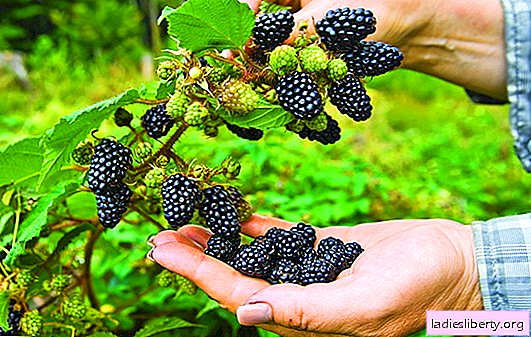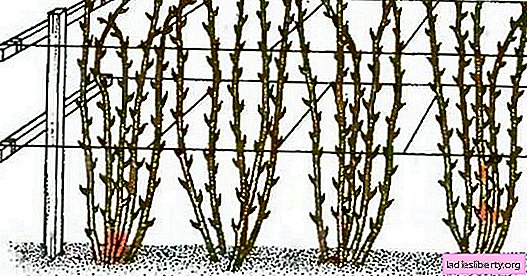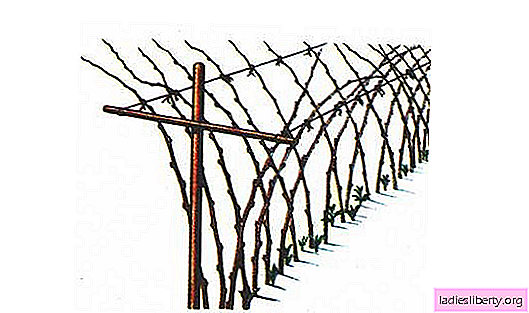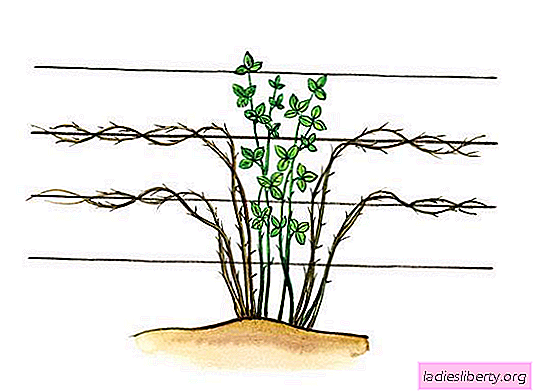
Blackberries are suitable for breeding in almost all regions of Russia.
This shrub is undemanding to the soil, needs a good light and care, consisting in dressing, regular watering and pruning.
There are many varieties for cultivation, including hybrids with raspberries. Planted bush will bear fruit for about 15 years.
How to choose planting material for growing blackberries?
The method of introduction of this crop on the garden plot depends on the variety of blackberry selected for breeding.
Straight-growing varieties propagate by cuttings and young processes, while creeping blackberries have weak roots, and therefore they propagate due to the upper processes (layering), by seeds or by separation of young shoots.
Upright semi-shrubs have a strong root system and are not suitable for breeding in areas with high-lying groundwater level (1-1.5 meters). But then, in comparison with creeping varieties, they are distinguished by the best frost resistance, they can reach up to 2.5 meters in height.
The best option to start breeding culture is spring planting cuttings. A healthy planting material has flexible appendages and healthy, undried roots.
To check its quality, a small part of the epidermis should be removed from the stem - the green part of the primary cortex should be located under it. Brown dry stalk says that the plant is not suitable for breeding, but in large quantities can serve as brushwood for the production of ash. Wet flexible root should not have wrinkles - a clear sign of wilting.
When choosing blackberry seeds, we advise you to prefer non-bearing, high-fruit varieties, the agrotechnical requirements of which meet the climatic conditions of your area.
For breeding blackberries growing on the site, you should choose young two-three-year-old offspring for grafting or the longest processes for breeding apical layering.
Choosing a place on the site for blackberry. Preparing the soil for planting
Blackberries are well propagated by offspring, forming impenetrable thickets in nature, and on the site - polonaa as weed adjacent areas. Therefore, future planting should be placed at a sufficient distance from fences, greenhouses and ridges. This will ease care for her and protect other cultures from her “raids”.
The best place to grow blackberries is sunny, protected from the wind space. Both the first and second requirement is mandatory. It is important not only to plant in a sunny place, but also to thin out in the future, to form a bush so that all the shoots are covered sufficiently. If there is no shelter from the wind, it should be created, because fragile fruitful stems break faster than raspberries.
If the groundwater level runs high enough, you need to raise the place for landing, making the embankment. The blackberry root system is lower than that of raspberries, making it fairly drought tolerant, but at the same time vulnerable when exposed to groundwater.
When choosing a land for planting, one should avoid calcareous soils, preferring slightly acidic or neutral loamy soils. If the soil in your area does not meet these requirements, you should create the necessary soil mixture yourself, adding lime and wood ash to strongly sour soils, loam and black earth for sandy and sandy soils, sand and rotted sawdust or leaves, lime, peat for additional drainage of heavy clay soils. If the soil is alkaline, it should be "neutralized" using nitrogen fertilizers.
Depleted soil and land with a high sand content should be well fertilized before planting, making nitrogen and mineral fertilizers, peat, black soil, wood ash and compost.
How to plant blackberry cuttings?
The landing scheme should follow the general rules: 2 m. Between the rows, 1 m. Between the bushes. With the fan-shaped formation of shoots, the distance between the bushes increases and is 2 m., While the cuttings themselves are planted in a staggered manner in two rows at a distance of 40 cm from each other, and then 2 m further. in the aisle. These requirements are based on the plant’s high need for sunlight and the need to protect the green mass from diseases associated with excessive overcrowding. In addition, plants with wide aisles are easier to process.
Each row of plants in the future will be tied to the trellis, so the necessary structures of the columns and the wire stretched between them are set in advance. The trellis will protect the blackberry from damage, allow the bush to be properly formed, make it easier to take care of the plants. The wire should be stretched in several levels: 70 cm. From the ground, 1 m., 1.30 cm. And so on. Here are examples of how to install such facilities.


Each bush should be planted in a separate landing pit with an area of about 40 sq. Cm. At the bottom of the pit lay out a bucket of rotted manure, compost, 50 grams. potash fertilizer, 100 gr. superphosphate. Then add fertile soil to the pit, mix everything up, form a sloping hill, sprinkle it on 10 cm fertile soil (to prevent root burn). From above establish a stalk, straightening the roots, sprinkled with fertile ground, aligning the pit. The upper layer is mulched with peat or rotted sawdust, and then irrigated. This method of planting allows you to avoid additional fertilizing for full maturity of the bush, it is about three years.
After planting, the first cut of the stems is made, leaving up to 20 cm. If diseases are suspected, the stems are cut off almost completely. In the future, the bush will be formed from 4 x to 7 fruit-bearing branches, depending on the variety.
We plant blackberries with seeds
This method of growing blackberries is the longest, but at the same time the most reliable: you get exactly those varietal characteristics that are declared by the manufacturer. For example, in the process of breeding cuttings, the plant may lose its spinelessness, while reproduction by seeds will keep all the best properties of the variety.
Blackberry seeds hatch up for a long time, so it is appropriate to do the start-up: put the seeds on canvas and, keeping the humidity and temperature from 24 to 26 gr., Periodically sprinkle them with a weak solution of growth stimulant for 5 days. Then the seeds are planted in boxes filled with a mixture of sand and peat, to a depth of 5-7 mm., At a distance of 3 cm. from each other.
After receiving the 4th of this leaflet, young plants should be hardened and transferred to the open ground, having landed at a distance of 10-15 cm from each other. Over the summer, the seedlings will grow, but not enough to survive the winter. Therefore, preparing for the cold, you should cover the young plants with leaves and spruce branches.
Next spring, the seedlings are transferred to a permanent place, keeping a lump of earth at the roots when it is transplanted. Agrotechnika planting is the same as cuttings. The blackberry grown in this way will produce the first crop in two to three years.
How to propagate the growing blackberry on the site?
There are several ways to increase existing blackberry landings:
1. root cuttings by dividing the bush;
2. green cuttings;
3. apical processes.
Reproduction root cuttings carried out in two ways. The first one begins in autumn, for this, an adult three-year-old bush is dug out and divided, using only roots from 0.7 cm thick for each individual stepson. Stems are cut off, leaving up to 10 cm at the root. The cuttings thus obtained are stored in the basement in wet sand, not allowing for drying and exposure to negative temperatures. In the spring cuttings are planted immediately to a permanent place.
The second method of root grafting is carried out in the spring. To do this, dig up a bush and cut the cuttings obtained by dividing at a distance of 15-20 cm from the root and land immediately on a permanent place, putting the cutting not vertically, but horizontally, so that the lower buds are covered with earth. A bush planted in such a way will give two or three main stalks at once.
Reproduction green cuttings is to get stepchildren from green stalks. To do this, cut the long stem (it should have buds and leaves), process the cut with a growth stimulant solution and place it in a container filled with wet and loose soil mixture. Maintaining a high level of moisture and heat provoke the appearance of roots. After a month and a half cuttings should be landed on a permanent place.
Reproduction of the apical processes spend for creeping blackberries. To do this, individual adult stems are bent to the ground, pinned and sprinkled with earth. The sapling received in a year is transferred to a new place.
Blackberry care: molding, thinning, watering
With the beginning of spring, blackberry bushes are freed from winter "insulation" and proceed to pruning and further forming the stems. Pruning is carried out to reduce the number of fruit bearing branches (from 4 x to 7 cm is preserved), shortening individual stems in order to increase the mass of berries, improve their quality and, in general, the fruit of the bush. Pruning old and unnecessary branches and leaves allows the bush to penetrate so that the air does not stagnate in plantations. This simple procedure will help to cope not only with dense thickets, which are quickly formed in uncontrolled plantings, but also to prevent various “blackberry” diseases.
Forming branches and stems is carried out to evenly distribute the ground part of the plant on the trellis so that sunlight will evenly fall on the bush from all sides. In addition, molding allows us to simplify the harvesting process and will allow fragile fruit-bearing branches not to break in the wind under the weight of the berries.

For straight blackberry varieties, molding is done by attaching individual stems and branches to the trellis. For creeping blackberry varieties, the forming is in the direction of the growth of the stems along the trellis. To do this, each stem is twisted several times over the wire, directing it parallel to the ground or with a slope down.
When fan molding is usually divided fruiting stems and those that are just gaining strength. To do this, in the first year, the growing stems bend in one direction, the next year, the new growing stems and branches are directed in the opposite direction.

In order for the stem to give more branches, you should pinch it on reaching 50-60 cm. Length. In addition to additional branching, the number of buds on the main stem will increase. In the fall, another pruning is carried out, this time removing the old, stiff branches.
Thinning is carried out when the extra stepchildren interfere with the growth of the main bush. Doing thinning, we should not forget that the ground part of the bush is updated every two to three years. To get rid of weeds should be all the time, loosening the top layer of soil, not only in rows, but also in between rows.
Watering during the cultivation of blackberries is carried out regularly, with warm, settled water. Depending on the amount of precipitation, watering is done once a week or once every two weeks. The blackberry root system goes deeper than that of a raspberry, but this property should not be abused, limiting watering or increasing the duration of its implementation. Lack of moisture will affect the yield reduction, and an overabundance will lead to rotting.
Top dressing, fertilizers, harvesting
In the third year of blackberry cultivation, complex fertilizers should be applied: potassium phosphate and nitrogen. One should not get carried away with this or that component, since an excess of mineral elements inhibits the growth and development of plants, and the addition of nitrogen to the soil above the required measure will result in an increase in greenness to the detriment of berries, the plant will not have time to prepare for winter.
With the beginning of spring on each square meter of planting make 15 grams. urea or 20 gr. ammonium nitrate, in the fall - on the same area - 100 gr. superphosphate and 30 gr. potassium fertilizer (chlorine free). Each of these fertilizers can be replaced by a similar, including natural - slurry and wood ash.
The ground at the roots should be periodically mulched with rotted manure, peat and compost. The top layer of mulch of 5-10 cm will not only enrich the soil with the necessary micro and macro elements (which penetrate to the roots with water), but will also delay the release of moisture from the surface of the earth.
The first harvest will delight in the third year after planting, with one bush you can average 4-5 liters. berries If the blackberry will give inflorescences in the first or second year after planting, they should be removed in order not to undermine the health and development of the bush by early fruiting.
Blackberry Diseases and Pests
Despite the fact that in comparison with raspberries, blackberries are more resistant to diseases, infection with them while growing blackberries can still cause damage to the plant and its fruitfulness.
Blackberry flowers may be damaged raspberry-strawberry weevil, turn yellow and fall to the ground. The pest is destroyed by periodic loosening. When in contact with the ground or when it is very thick, individual stems can become infected with gray rot. To combat it, it is enough to cut off the infected leaves and stems, strengthen the branches on the trellis and watering under the root.
Infection leaf aphids can be cured by destroying garden ants and treating the tops of the branches with a soap and ash solution. Viral diseases that aphids endure to grow blackberries, unlike raspberries, are not dangerous.
Another pest is raspberry stem galitsa, initially affects the base of the shoots, the next year - shoots along the entire length. The affected processes should be immediately cut and destroyed.
Damage spider mite the plants dry out, so you should immediately after the detection of the pest, treat the blackberry with Neoron or Actellic.
In general, blackberries, which do not have "raspberry genes", are practically not exposed to diseases and pest invasion.











